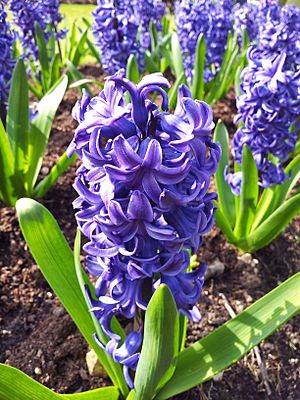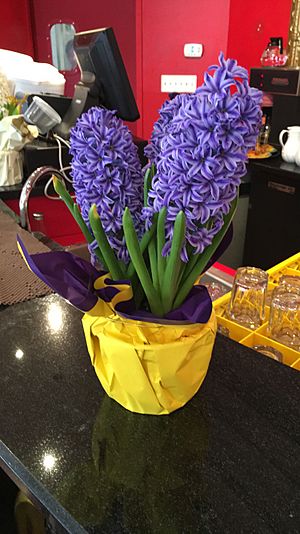Hyacinth facts for kids
Quick facts for kids Hyacinth |
|
|---|---|
 |
|
| Cultivar of Hyacinthus orientalis | |
| Scientific classification |
|
| Kingdom: | Plantae |
| Clade: | Tracheophytes |
| Clade: | Angiosperms |
| Clade: | Monocots |
| Order: | Asparagales |
| Family: | Asparagaceae |
| Subfamily: | Scilloideae |
| Genus: | Hyacinthus Tourn. ex L. |
| Type species | |
| Hyacinthus orientalis |
|
| Species | |
Hyacinths are beautiful bulb plants that bloom in spring. They are known for their amazing smell and colorful flowers. These plants belong to a small group of plants called Hyacinthus. You can find them naturally in the eastern Mediterranean area, from southern Turkey to Israel/Palestine. However, people have planted them in many other places around the world.
It's easy to confuse hyacinths with other plants! For example, some plants from the Brodiaea and Scilla groups are also called "hyacinths." But they are not true hyacinths. Also, don't mix them up with Muscari, which are often called "grape hyacinths."
Contents
What Hyacinths Look Like
Hyacinths grow from a bulb, which is like an underground storage unit for the plant. Each bulb usually grows about four to six long, thin leaves. It also produces one to three tall flower stalks. These stalks have many flowers clustered together.
In the wild, hyacinth flowers are usually spread out on the stalk. Some types, like H. litwinovii, might have only two flowers per stalk. The H. orientalis usually has six to eight flowers and grows about 15 to 20 centimeters (6 to 8 inches) tall. The hyacinths you see in gardens are often special types of H. orientalis. They have much fuller flower stalks and are generally stronger plants.
The Story Behind the Name
The name Hyacinthus comes from an old Greek story. In Greek myths, there was a handsome young man named Hyacinth. The god Zephyrus was jealous of him and accidentally killed him. The story says that hyacinth flowers grew from Hyacinth's blood. The ancient Greeks used the name hyakinthos for a plant, which might have been Scilla bifolia or another flower.
Long ago, scientists like Carl Linnaeus used the name Hyacinthus for many different plants. But over time, they realized that many of these plants were actually different groups. So, the Hyacinthus group became much smaller.
Types of Hyacinths
Today, scientists usually recognize three main types of hyacinths in the Hyacinthus group:
- Hyacinthus litwinovii
- Hyacinthus orientalis – This is the most common type, often called the Dutch or garden hyacinth.
- Hyacinthus transcaspicus
Some experts think that H. litwinovii and H. transcaspicus should be in a different group called Hyacinthella. If that were true, then Hyacinthus would only have one species: H. orientalis.
Where Hyacinths Grow
Hyacinths are originally from the eastern Mediterranean region. This includes countries like Turkey, Turkmenistan, Iran, Iraq, Lebanon, Syria, and Palestine.
However, people have planted hyacinths in many other places. Now, you can find them growing wild in parts of Europe, like the Netherlands and France. They also grow in Korea, North America (the United States and Canada), Mexico, Cuba, and Haiti.
Growing Hyacinths
The Dutch hyacinth (H. orientalis) is very popular for gardens and homes. It comes from Southwest Asia. In the 1700s, it was so popular that over 2,000 different types were grown in the Netherlands. The Netherlands is still a big producer of hyacinths today.
These hyacinths have a single, dense stalk of very sweet-smelling flowers. They come in many colors, such as red, blue, white, orange, pink, purple, or yellow. A smaller type, called the Roman hyacinth, has blue or white petals. These flowers like indirect sunlight and need to be watered carefully, not too much.
Safety First! (Toxicity)
It's important to know that hyacinth bulbs are poisonous. They contain a substance called oxalic acid. If you touch hyacinth bulbs, they can cause a mild skin rash. It's a good idea to wear gloves when handling them.
Remember, some plants that are called "hyacinths" are not true hyacinths. For example, the tassel hyacinth is edible and used in cooking in some Mediterranean countries. But true hyacinth bulbs are not safe to eat.
Hyacinths in Culture
Hyacinths are often linked to spring and new beginnings. In the Persian New Year celebration, Nowruz, hyacinths are placed on a special table called the Haft-Seen. This celebration happens at the start of spring. The Persian word for hyacinth is sonbol.
In Ancient Greece, the name hyakinthos was used for at least two different plants. These plants were considered sacred to the goddess Aphrodite.
The hyacinth also appears in a famous poem called The Waste Land by T. S. Eliot. In the poem, the narrator talks about a "hyacinth girl" and a "Hyacinth garden."
You gave me hyacinths first a year ago;
"They called me the hyacinth girl."
—Yet when we came back, late, from the Hyacinth garden,
Your arms full, and your hair wet, I could not
Speak, and my eyes failed, I was neither
Living nor dead, and I knew nothing,
Looking into the heart of light, the silence.
In the Roman Catholic religion, the H. orientalis flower represents qualities like being careful, staying strong, wanting to go to heaven, and having a calm mind.
Hyacinth Colors
The blue color of hyacinth flowers can vary a lot. It can be a 'mid-blue', a deep violet blue, or a bluish purple. There's even a special American color name called Persenche for a certain shade of hyacinth blue. This color is mostly ultramarine blue, with a little bit of red and white.
Images for kids
-
Many hyacinth types at Floriade, Canberra.
-
More hyacinth types at Floriade, Canberra.
-
White and purple hyacinths in Detroit, Michigan.
See also
 In Spanish: Jacinto para niños
In Spanish: Jacinto para niños
- Tekhelet - an ancient blue dye, sometimes linked to the color of hyacinths.








